I have a simple snowflake schema out of which I generated my Entity Framework model.
The problem is that I am trying to map a child entity to an existing parent and/or grandparent entity, but it still inserts it.
I followed this:
Insert new object with existing object
Prevent Entity Framework to Insert Values for Navigational Properties
The interesting thing is that even though the EntityState of the parent entities is "Unchanged" the Entity Framework still tries to insert it.
The Schema

CarRepository.Save() method
public void Save(Car car)
{
using (DBContext context = new DBContext())
{
// No need to save if it already exists
if ( context.Cars.FirstOrDefault(x => x.RegistrationNumber == car.RegistrationNumber) != null)
{
return;
}
else
{
// Check if the parent POCOs exist in the DB.
Model existingModel = context.Models.FirstOrDefault(x => x.Name == car.Model.Name);
Manufacturer existingManufacturer = context.Manufacturers.FirstOrDefault(x=> x.Name == car.Model.Manufacturer.Name)
Trader existingTrader = context.Traders.FirstOrDefault(x=> x.Name == car.Trader.Name)
TraderCompany existingTraderCompany = context.TraderCompanys.FirstOrDefault(x=> x.Name == car.Trader.TraderCompany.Name)
context.ContextOptions.LazyLoadingEnabled = false;
//Attach to the context if existing in the DB, i.e mark the existing POCOs not to be added the DB
if (existingModel != null)
{
car.Model = existingModel;
Assert.IsTrue(context.ObjectStateManager.GetObjectStateEntry(car.Model).State == EntityState.Unchanged);
}
if (existingManufacturer != null)
{
car.Model.Manufacturer = existingManufacturer;
Assert.IsTrue(context.ObjectStateManager.GetObjectStateEntry(car.Model.Manufacturer).State == EntityState.Unchanged);
}
if (existingTrader != null)
{
car.Trader = existingTrader;
Assert.IsTrue(context.ObjectStateManager.GetObjectStateEntry(car.Trader).State == EntityState.Unchanged);
}
if (existingTraderCompany != null)
{
car.Trader.TraderCompany = existingTraderCompany;
Assert.IsTrue(context.ObjectStateManager.GetObjectStateEntry(car.Trader.TraderCompany).State == EntityState.Unchanged);
}
//Mark the Car for Addition to the DB
context.Cars.AddObject(car);
context.ObjectStateManager.ChangeObjectState(car, EntityState.Added);
//If the POCOs do not exist in the DB mark them for addition
if (existingModel == null)
{
context.ObjectStateManager.ChangeObjectState(car.Model,EntityState.Added);
}
if (existingManufacturer == null)
{
context.ObjectStateManager.ChangeObjectState(car.Model.Manufacturer,EntityState.Added);
}
if (existingTrader == null)
{
context.ObjectStateManager.ChangeObjectState(car.Trader,EntityState.Added);
}
if (existingTraderCompany == null)
{
context.ObjectStateManager.ChangeObjectState(car.Trader.TraderCompany,EntityState.Added);
}
context.SaveChanges();
}
}
}
Edit:
After a few days of tinkering I managed to come up with a workaround which worked for me.
It seems that the Car that is being passed to the CarRepository.Save() has some kind of internal context which is undetectable... That being so, it is impossible to detach it from that context/s and add it to the one in CarRepository.Save(). In order to actually add it to this context I deep/lazy copy the Car object and its navigation properties, if existing.
The workaround
public void Save(Car car)
{
using (DBContext context = new DBContext())
{
// No need to save if it already exists
if ( context.Cars
.Any(x => x.RegistrationNumber == car.RegistrationNumber))
{
return;
}
else
{
//Assign scalar properties to the deep copy
Car carToBeSaved = new Car
{
carToBeSaved.RegistrationNumber = car.RegistrationNumber,
carToBeSaved.Price = car.Price
}
//Car -> Trader -> ...
if(car.Trader != null)
{
Trader existingTrader =
context.Traders
.FirstOrDefault(x => x.Name == car.Trader.Name);
//If exists in DB assign, if not deep copy
carToBeSaved.Trader = existingTrader ??
new Trader
{
Name = car.Trader.Name,
JobTitle = car.Trader.JobTitle
}
//Car -> Trader -> TraderCompany
if(car.Trader.TraderCompany != null)
{
TraderCompany existingTraderCompany =
context.TradersCompanys
.FirstOrDefault(x => x.Name == car.Trader
.TraderCompany
.Name);
//If exists in DB assign, if not deep copy
carToBeSaved.Trader.TraderCompany = existingTraderCompany ??
new TraderCompany
{
Name = car.Trader.TraderCompany.Name,
Address = car.Trader.TraderCompany.Address,
PhoneNumber = car.Trader.TraderCompany.PhoneNumber
}
}
}
//Car -> Model -> ...
if(car.Model != null)
{
Model existingModel =
context.Models
.FirstOrDefault(x => x.Name == car.Model.Name);
//If exists in DB assign, if not deep copy
carToBeSaved.Model = existingModel ??
new Model
{
Name = car.Model.Name
}
//Car -> Model -> Manufacturer
if(car.Model.Manufacturer != null)
{
Manufacturer existingManufacturer =
context.Manufacturers
.FirstOrDefault(x => x.Name == car.Model
.Manufacturer
.Name);
//If exists in DB assign, if not deep copy
carToBeSaved.Model.Manufacturer = existingManufacturer ??
new Manufacturer
{
Name = car.Model.Manufacturer.Name
}
}
}
//Mark the Car for Addition to the DB
context.Cars.AddObject(car);
context.SaveChanges();
}
}
}
If someone have any thoughts on this, please share.
Thanks.